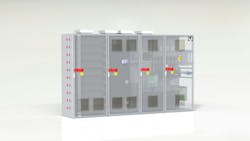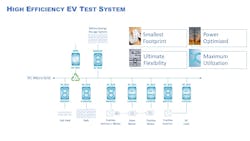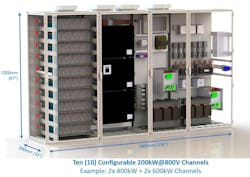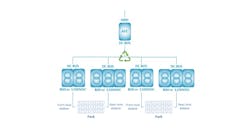A More Efficient and Customizable Battery Testing System
Battery testing is an important part of the electric vehicle development process as it helps to ensure batteries will perform as desired in a given application. Use of a battery tester can validate performance and predict a battery’s behavior in various operating scenarios to enable better fine-tuning of range, charging and efficiency.
To aid testing of batteries for a range of electric vehicle types, Unico – a developer of drive products and systems – has introduced its Quantum Drive Platform. Designed specifically for battery testing, it allows users to test multiple cells, modules and packs in the same system with a single connection to the grid.
“In the past…if you wanted to test one [battery] pack, you would have one power connection to the facility,” explained Don Wright, VP of Engineering at Unico, in an interview with Power & Motion. “What we're able to do now is if somebody wants to test eight battery packs, we can have one system that has eight channels on it, and then only one grid connection.”
This provides opportunities for energy savings while ensuring the system is able to meet a customer’s various testing requirements.
READ MORE: Battery Sizing Key First Step in Electric Vehicle Development
New Controller Architecture Allows Reductions in Energy Use
Unico has a long-standing history of developing drive and controller technology which it has applied to battery testing systems. The Quantum Drive Platform came about when the company determined it needed to update its controller architecture to better handle the processing power required of current applications.
The updated controller architecture “allows us to do advanced applications easier,” said Wright. “It allows us to open up some of that controller architecture to our customers, so they can do some more advanced things.”
But the real benefit he said is the ability to set up algorithms for sharing energy in the battery test systems. The Quantum Drive Platform allows for “back-to-back” battery testing in which energy discharged from one channel within the system can be used as charge energy for another, minimizing wasted energy and improving overall efficiency.
“If you're building a battery lab and you have 20 battery pack testers that are in the megawatts of size, instead of needing all of that power coming in from the grid, while you're discharging one battery you can charge another battery,” explained Wright. “If you align your test profiles correctly, then this can dramatically reduce the energy usage inside of the facility.”
A Battery Energy Storage System (BESS) can be connected to the system to store and reuse the energy at a later date as well.
Through the energy savings which can be achieved, there is an opportunity to lower overall operational costs. And because the platform enables a single system with one grid connection to be used to test multiple batteries, further savings can be achieved as installation costs and space are also reduced.
“The Quantum Drive Platform is being set up to support all of these different applications where we can try to utilize the energy in test labs much better,” said Wright.
Not only can this benefit a test lab’s operational costs but also sustainability initiatives it may be undertaking to lower its impact on the environment. Finding ways to reduce energy consumption is a key part of this equation for many companies.
READ MORE: Manufacturers Increase Sustainability Initiatives
Customizable for Various Battery Testing Applications
The Quantum Drive Platform features high-performance DC (direct current) channels which are tailored for battery cell, module and pack testing. Multiple channels of each type and different output voltage levels can be included for testing various types of batteries, allowing customization to specific user needs.
Wright said the platform can be used to test batteries of varying sizes such as those used in small scooters and compact construction equipment all the way up to the big battery packs used in large mining equipment.
In addition, Unico’s AC (alternating current) drives can be added to the system to allow testing of components based on AC, DC or a combination of both, further adding to the configurability possible with the battery testing system to meet a variety of industry and application needs.
According to Wright, Unico’s newest battery testing system is suitable for everyone dealing with batteries in some manner. This includes those who are developing battery packs as well as the subpacks and modules. “They want to utilize this test equipment to prove out their designs and provide [specifications],” he said.
OEMs and system integrators who would be equipping their electric vehicles with batteries are also a target customer for the system. Wright said they would use it to verify the battery technology they have chosen will work throughout the lifespan of their vehicles.
He said the testing system can also be used by those who want to recycle electric vehicle batteries or utilize them in a second life application. They can use the system to see how much life may be left in a battery to determine if it truly is at the end of its life or if there is enough energy left within it to be used in another application such as grid storage.
More Electrification Will Expand Testing Needs
Battery testing requirements will need to continue advancing as more applications transition to electrification. Wright said one of the things OEMs in the mobile machinery space, such as agricultural equipment, will want to understand is what kind of a load a particular machine may have on a battery.
There is already a lot of industry expertise related to the driving profiles of on-road electric vehicles. “But a digger or an agricultural machine will have a different load profile on that battery,” he said.
The heavy-duty mobile equipment market is still in the earlier stages of the electrification transition, and there are a number of duty cycles and application uses which have to be considered compared to those of a car or truck which drives on the road. As such, there could be new challenges faced by the implementation of battery-electric powertrains in these heavier duty off-road applications requiring new battery testing capabilities.
READ MORE: Construction Equipment Digs Deeper into Electrification
“We need to make sure that the test equipment can appropriately test the batteries as if they were really in a tractor…so [OEMs] can understand that their batteries are going to last for a long time,” said Wright.
“As more and more industries are moving towards electrification and as we have our first results back from the first and second round of electric vehicles, we're learning new things all of the time,” he said. Using what has been learned from the first generations of electric vehicles, testing can be re-evaluated and updated where necessary to overcome any previous issues and ensure future designs meet industry needs.
Watch Unico's video below to see how its testing technology can benefit electric vehicle development.
About the Author
Sara Jensen
Executive Editor, Power & Motion
Sara Jensen is executive editor of Power & Motion, directing expanded coverage into the modern fluid power space, as well as mechatronic and smart technologies. She has over 15 years of publishing experience. Prior to Power & Motion she spent 11 years with a trade publication for engineers of heavy-duty equipment, the last 3 of which were as the editor and brand lead. Over the course of her time in the B2B industry, Sara has gained an extensive knowledge of various heavy-duty equipment industries — including construction, agriculture, mining and on-road trucks —along with the systems and market trends which impact them such as fluid power and electronic motion control technologies.
You can follow Sara and Power & Motion via the following social media handles:
X (formerly Twitter): @TechnlgyEditor and @PowerMotionTech
LinkedIn: @SaraJensen and @Power&Motion
Facebook: @PowerMotionTech

Leaders relevant to this article:





